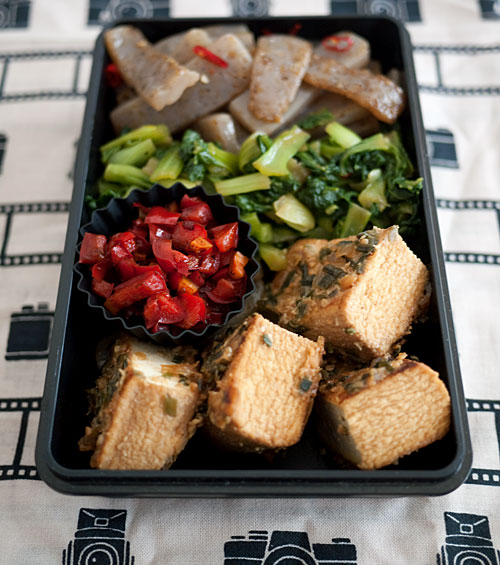Bento no. 78: Vegan low-carb, low calorie, 'zen' bento

Bento contents:
- Fried tofu (atsuage) with negimiso, 150 calories
- Konnyaku sautéed with ginger, garlic and chili peppers (variation of Konnyaku aglio olio e peperoncino), 50 calories
- Sweet pepper and carrot confetti, 30 calories
- Steamed baby pak choi with sesame oil, 20 calories
Total calories (approx): 250 (how calories are calculated)
Time needed: 30 minutes (if all components are made in the morning, much less time if you make things in advance)
Type: Japanese, low carb, low calorie, vegan, "zen"!
You do not see me using the word "zen" lightly on my blogs. I think it's been misused, and abused, to mean anything that is simple. But if I were to describe any bento that's been on these pages as being 'zen', this one would be it. It is vegan, fairly low in calories (only 250 for this big box full of food), low-carb, and gluten-free if you use a wheat-free miso. But it's still filling and delicious. Well, I think it's delicious, though some people may have some trouble with the konnyaku part.
The individual recipes are already given elsewhere except for the steamed pak choi, but to describe them all briefly:
- For the fried tofu with negimiso, I used atsuage or nama age (see Looking at tofu) which is pre-fried tofu. I love using atsuage for bentos, since unlike regular tofu you don't need to drain out the moisture and so on - it can be used straight out of the packet. Just drain off the liquid it comes in, cut up, and dry-roast in a non-oiled frying pan until the pieces are heated through and crispy on the outside. Spread with a bit of pre-made negimiso on one side, flip over for a few seconds on the miso-spread side, then take out of the pan to cool before packing.
- The Konnyaku sautéed with ginger, garlic and chili peppers is leftovers, and is a variation of Konnyaku aglio olio e peperoncino; I reduced the garlic to 1/2 a clove for a whole block of konnyaku (and kept most of the garlic off the portion I set aside for the bento), and added a little chopped ginger.
- The Sweet pepper and carrot confetti was made in advance and stashed in the refrigerator.
- The baby pak choi was just washed, cut up, put on a microwave-safe plate, covered and microwaved on High (at 1000 watts) for 5 minutes. I drizzled a tiny bit of sesame oil on it. I didn't add salt, since the other items in the bento are already well seasoned. The pak choi became my bland foil in this bento, in lieu of plain rice.
All the fiber-rich foods in this bento - the konnyaku in particular - fill you up so you don't feel hungry afterwards. The use of vegetable oil in judicious amounts helps that feeling of satiety too I think. There's still a lot of nutritious food in there too, and I think I kept it colorful and appetizing looking enough so that you don't feel deprived visually.
I realize this is a rather hard-core bento which may make bento (or Japanese food) beginners running away screaming in horror...but if you're up to the challenge, I hope you give it a try! ^_^
The box I used
The box I used here is a plain black model from Mujirushi Ryohin, aka Muji. It has a clip-on, leakproof lid and is very practical. It's usually a box I use for The Guy, since it's large (900ml capacity) but I used it here for me. More about Muji bento boxes that are available outside of Japan.
If you enjoyed this article, please consider supporting this site by becoming my patron via Patreon.
